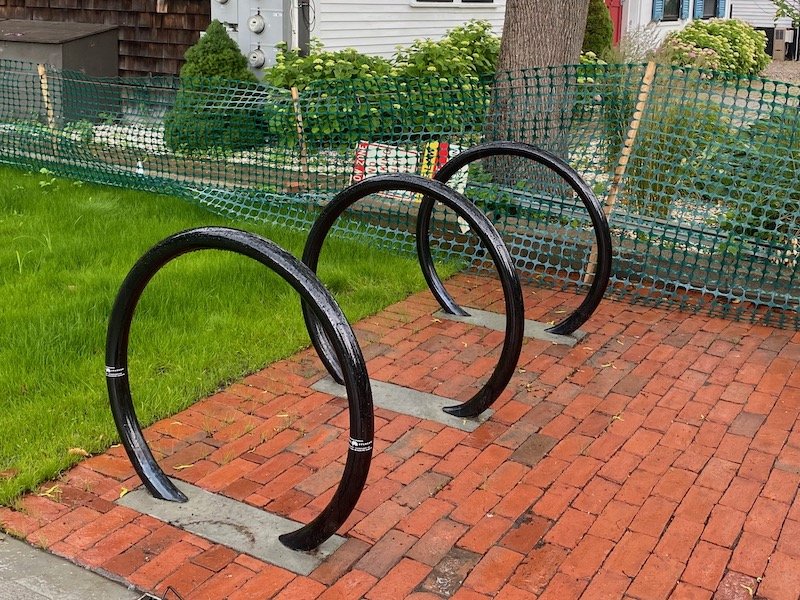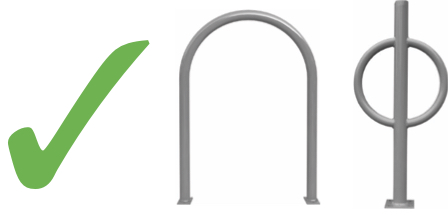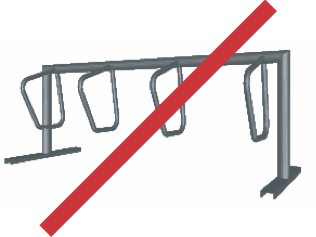Choosing Bike Racks
Rack Styles
The most useful style of rack is the “inverted U”. These are the kind of racks that town has been installing.
This style is preferred because it can support a bike at two points to prevent it from falling over. These are easy to lock a bike to since the rack is at the center of the bike. They can be purchased as a single inverted U that can be permanently affixed in the ground or in multiple units (sometimes called a “corral”) that can be permanently bolted to the ground.
We suggest following the Association of Pedestrian and Bicycle Professionals (APBP) Essentials of Bike Parking guide. It provides recommendations on what makes for a high-quality bike rack. The Town follows these guidelines when making its own purchases.
Bike corrals in parking spaces at the Johnson Street Parking Lot in Provincetown (2018). Each corral can hold 10 bicycles.
Recommended Bike Racks
In confined spaces, small racks work well for squeezing in a couple of bikes here and there or in short row.
“Inverted-U” racks are common in cities and are often along sidewalks in business districts. These are sometimes called “staples,” “stalls,” or “stands.”
“Post-and-ring” racks are another good solution for tight spaces. They attach with just one post to the ground (usually embedded in a cement sidewalk), so installation is simpler and more stable than an inverted-U. These are the standard in Cambridge, MA, Boston, MA, and Toronto, ON.
Post & ring racks installed at the Bas Relief Park in Provincetown.
New inverted hoop bike racks at the Pilgrim Monument’s Bradford Street elevator entrance in Provincetown.
In short, multiple inverted-U's on rails are best for surface-mount or freestanding applications, while individual inverted U's or post-and-rings are well suited to in-ground mounting.
Inverted-U's on rails create a free-standing "corral" or "stadium" rack
Inverted U or Post-and-ring racks
DON’t INSTALL THESE RACKS
Grid or schoolyard racks that require you to lift up the front tire and squeeze it in between metal bars (these are known as “wheelbenders” since they can damage the bike’s front wheel when the bike inevitably falls over);
Indoor garage racks that you’d put on the floor that only hold the front tire;
Wave or loop racks, which don’t support a bike frame in two places;
Coathanger racks, which don’t support a bike frame in two places;
Vertical racks, which require lifting a bike off the ground and can’t accommodate different bike styles or configurations (baskets, fenders, trailers, etc.).
Wave racks
Tilted wave racks
Coathanger racks
Grid or schoolyard racks
Materials
In terms of material, a galvanized finish is preferred since powder-coated steel racks will rust quickly and deteriorate in the salt air (the racks installed at Town Hall in 2010 were replaced in 2018 due to corrosion).
If you want a color for the rack, choose a thermoplastic coated metal rack.
Wood racks might look nice at first, but they don’t hold up in our weather and they are usually designed like a schoolyard rack so they’re not very useful (you see some of these in the Seashore). Plastic racks fall in the same category.
Location
Your bike racks should be either in the same place as your car parking or near the main entrance to your business or building (no further than 50 feet). Don’t put them in back by the dumpster or under the stairs. If lots of your employees commute by bike, consider a separate bike parking area for them so that your customer bike parking isn’t full.
If possible, locate the racks on a solid, paved surface. Bike kickstands won’t keep a bike upright on mulch, shells, gravel, or grass. If you do place the racks on grass, be mindful if you have a sprinkler system — if you’re watering the bike racks, they (and the bikes) will get damaged quickly by rust.
Layout
When you’re figuring out where to put your racks, consider the spacing. Inverted U or post & ring racks should be spaced 36” apart.
You’ll need clearance both front and back, so keep the rack at least 36” from any obstacle like a wall, shrubs, or adjacent walkways. See the APBP and City of Cambridge standards linked at the bottom of this page for more detail.
Rack manufacturer Dero has an easy to use and comprehensive guide to choosing and locating bike racks that goes into more detail (PDF): https://www.dero.com/bike-parking-guide/
Minimum number of bike spaces
How many bike parking spaces do you need? Since bikes are a primary mode of transportation in Provincetown, here are suggested minimums:
one bike space per bedroom or hotel room;
one bike space for each car parking space required by zoning;
one bike space for every 4 restaurant seats.
Note that each post-and-ring or inverted U is equal to two bike spaces, since a bike can be parked on both sides.
The town’s Planning Board often conditions special permits to require bike parking spaces. The conditions often require approval of the layout and rack type by the Town Planner. Check your permits to see if there were specific numbers of spaces requested in your permit approvals.
Cost
Prices of racks range from $100 for a single inverted U rack to over $2,000 for a large capacity bike corral. Consider shipping costs in your budget as well, since racks aren’t typically stock items and need to be shipped to you.
Manufacturers
No endorsement is intended by listing these particular makers; they are just some we have looked at whose racks meet basic APBP guidelines:
Saris Infrastructure (Bike Corral Modular): https://www.sarisinfrastructure.com/product/bike-corral-modular
Creative Metal Works: http://www.creativemetalworksllc.com/
Park A Bike: http://www.parkabike.com/inverted-u-hoop-runner-hr120-series-bike-racks#Inverted+U+Bike+Racks+HR120+Series
American Bicycle Security: http://ameribike.com/bike-racks/standard/
The City of Portland, Oregon has a great list of many more manufacturers: https://www.portlandoregon.gov/transportation/article/339600
Online retailers
Again, no endorsement intended here – these are just a couple of online retailers we know of who carry some racks that meet the APBP guidelines:
Madrax (Double Sided U-Two Rack): https://www.madrax.com/u-two-ut160
Belson Outdoors: https://www.belson.com
The Park Catalog: https://www.theparkcatalog.com
Local bike shops may be able to order some bike racks, but they are usually the grid type which is not recommended.
More information
Association for Pedestrian and Bike Professionals (APBP) bike parking guidelines (PDF): https://www.apbp.org/assets/docs/EssentialsofBikeParking_FINA.pdf
Boston, MA Bike Parking Guidelines (PDF): https://www.boston.gov/sites/default/files/file/2021/02/Bike%20Parking%20Guidelines_v2.1.pdf
Cambridge, MA Bike Parking Guide (PDF): http://www.cambridgema.gov/~/media/Files/CDD/Transportation/Bike/Bicycle_Parking_Guide_20130926_2017PictureEdits.pdf?la=en
Dero Bike Parking Guide (PDF): https://www.dero.com/bike-parking-guide/
Google map of bike parking in Provincetown: http://bikept.org/map
Flickr photo album of bike parking around Provincetown: https://www.flickr.com/photos/rikahlberg/sets/72157649819833895/
If you have any questions, please contact us at info@bikeprovincetown.org











